Design, Analysis, and Experimentation of Space Deployable Segmented Solar Concentrator
Abstract
1. Introduction
2. DSSC and Deployable Mechanism Design
2.1. Research Method
2.2. Concept Design
3. Deployable Mechanism Error Modeling and Sensitivity Analysis
3.1. Error Modeling of Revolute Joints with Clearance
3.2. Comprehensive Error Modeling of Deployable Mechanism
3.3. Sensitivity Analysis Based on the Sobol Method
4. Scaled-Down Model Prototype Simulation Analysis
4.1. Parameter Definition
4.2. Afocal Reflective System Simulation
4.3. Solution of Comprehensive Error and Sensitivity Analysis of the Deployable Mechanism
5. Prototype Fabrication and Experimental Investigation
5.1. Experimental System
5.2. Positioning Repeatability Evaluation
5.3. Concentrating Ratio Evaluation
6. Discussion
7. Conclusions
Author Contributions
Funding
Data Availability Statement
Conflicts of Interest
Abbreviations and Nomenclature
| SSPS | Space solar power station |
| DSSC | Deployable segmented solar concentrator |
| ALPHA | Arbitrarily large phased array |
| OMEGA | Orb-shape membrane energy gathering array |
| ENZ | ε-near-zero |
| JWST | James Webb Space Telescope |
| Copt | Optical concentrator ratio |
| Cgeo | Geometric concentrator ratio |
| ri | Radial clearance of the i-th kinematic pair |
| di | Axial clearance of the i-th kinematic pair |
| Pose change of the shaft neck coordinate system Oji-xjiyjizji relative to the hole body coordinate system Obi-xbiybizbi | |
| Pactual | Actual position coordinates of the marker point |
| Pideal | Ideal position coordinates of the marker point |
| Angular radius | |
| Sj | First-order sensitivity coefficient |
| STj | Total sensitivity coefficient |
References
- Yang, Y.; Hu, J.; Zhu, L.; Pei, M. Multi-Layer and Multi-Objective Optimization Design of Supporting Structure of Large-Scale Spherical Solar Concentrator for the Space Solar Power Station. J. Renew. Mater. 2022, 10, 2835–2849. [Google Scholar]
- Seboldt, W.; Klimke, M.; Leipold, M.; Hanowski, N. European sail tower SPS concept. Acta Astronaut. 2001, 48, 785–792. [Google Scholar]
- Glaser, P.E. Power from the sun: Its future. Science 1968, 162, 857–861. [Google Scholar]
- Fan, G.; Zhang, Y.; Ji, X.; Yang, Y. Two-Layer Ring Truss-Based Space Solar Power Station. Energies 2022, 15, 2936. [Google Scholar]
- Yang, Y.; Fan, G.; Ji, X.; Pei, M. Modular Line-Focused Space Solar Power Satellite. Aerospace 2021, 8, 82. [Google Scholar]
- Sasaki, S.; Tanaka, K.; Higuchi, K.; Okuizumi, N.; Kawasaki, S.; Shinohara, N.; Senda, K.; Ishimura, K. A new concept of solar power satellite: Tethered-SPS. Acta Astronaut. 2007, 60, 153–165. [Google Scholar]
- Mankins, J.C. New developments in space solar power. NSS Space Settl. J. 2017, 1–30. [Google Scholar]
- Yang, Y.; Zhang, Y.; Duan, B.; Wang, D.; Li, X. A novel design project for space solar power station (SSPS-OMEGA). Acta Astronaut. 2016, 121, 51–58. [Google Scholar]
- Mankins, J.; Kaya, N.; Vasile, M. SPS-ALPHA: The first practical solar power satellite via arbitrarily large phased array (a 2011-2012 NIAC project). In Proceedings of the 10th International Energy Conversion Engineering Conference, Atlanta, GA, USA, 30 July–1 August 2012; p. 3978. [Google Scholar]
- Meng, X.; Du, K.; Bai, X.; Mankins, J.C.; Liu, C. Numerical investigation on improvement of energy transfer in solar power satellite. Renew. Energy 2020, 148, 103–112. [Google Scholar]
- Ji, X.; Zhang, Y.; Li, X.; Fan, G.; Li, M. Solar ray collection rate fluctuation analysis with Monte Carlo Ray Tracing method for space solar power satellite. Sol. Energy 2019, 185, 235–244. [Google Scholar]
- Fan, G.; Duan, B.; Zhang, Y.; Yang, Y.; Ji, X.; Li, X. Secondary concentrator design of an updated space solar power satellite with a spherical concentrator. Sol. Energy 2021, 214, 400–408. [Google Scholar]
- Li, X.; Duan, B.; Song, L.; Yang, Y.; Zhang, Y.; Wang, D. A new concept of space solar power satellite. Acta Astronaut. 2017, 136, 182–189. [Google Scholar]
- Li, X.; Fan, G.; Zhang, Y.; Ji, X.; Li, M. A fresnel concentrator with fiber-optic bundle based space solar power satellite design. Acta Astronaut. 2018, 153, 122–129. [Google Scholar]
- Liu, K.; Tan, G.; Duan, X.; Meng, X.; Wang, D.; Shan, Y. A Novel Concentrator Design for OMEGA Wireless Power Transmission System. In 2024 IEEE Wireless Power Technology Conference and Expo (WPTCE); IEEE: Kyoto, Japan, 2024; pp. 622–625. [Google Scholar]
- Greenhouse, M. The James Webb space telescope: Mission overview and status. In Proceedings of the 2016 IEEE Aerospace Conference, Big Sky, MT, USA, 5–12 March 2016; pp. 1–11. [Google Scholar]
- Reynolds, P.; Atkinson, C.; Gliman, L. Design and development of the primary and secondary mirror deployment systems for the cryogenic JWST. In Proceedings of the 37th Aerospace Mechanisms Symposium, Galveston, TX, USA, 19–21 May 2004; Volume 2944. [Google Scholar]
- Flores, P.; Ambrósio, J. Revolute joints with clearance in multibody systems. Comput. Struct. 2004, 82, 1359–1369. [Google Scholar]
- Tian, Q.; Flores, P.; Lankarani, H.M. A comprehensive survey of the analytical, numerical and experimental methodologies for dynamics of multibody mechanical systems with clearance or imperfect joints. Mech. Mach. Theory 2018, 122, 1–57. [Google Scholar]
- Erkaya, S.; Uzmay, İ. A neural–genetic (NN–GA) approach for optimising mechanisms having joints with clearance. Multibody Syst. Dyn. 2008, 20, 69–83. [Google Scholar]
- Erkaya, S.; Uzmay, İ. Optimization of Transmission Angle for Slider-Crank Mechanism with Joint Clearances. Struct. Multidiscip. Optim. 2009, 37, 493–508. [Google Scholar]
- Zijie, C.; Chuang, S.; Hongwei, G.; Rongqiang, L.; Zongquan, D. Design and accuracy analysis of a new high-rigidity modular planar deployable antenna mechanism. Eng. Struct. 2022, 253, 113770. [Google Scholar]
- Ren, J.; Zhang, J.; Wei, Q. Dynamic analysis of planar four-bar mechanism with clearance in microgravity environment. Nonlinear Dyn. 2024, 112, 15933–15951. [Google Scholar]
- Brutti, C.; Coglitore, G.; Valentini, P.P. Modeling 3D revolute joint with clearance and contact stiffness. Nonlinear Dyn. 2011, 66, 531–548. [Google Scholar]
- Yan, S.; Xiang, W.; Zhang, L. A comprehensive model for 3D revolute joints with clearances in mechanical systems. Nonlinear Dyn. 2015, 80, 309–328. [Google Scholar]
- Bai, Z.; Zhao, J. A study on dynamic characteristics of satellite antenna system considering 3D revolute clearance joint. Int. J. Aerosp. Eng. 2020, 2020, 8846177. [Google Scholar]
- Bai, Z.F.; Jiang, X.; Li, J.Y.; Zhao, J.J.; Zhao, Y. Dynamic analysis of mechanical system considering radial and axial clearances in 3D revolute clearance joints. J. Vib. Control. 2021, 27, 1893–1909. [Google Scholar]
- Li, J.; Huang, H.; Yan, S.; Yang, Y. Kinematic accuracy and dynamic performance of a simple planar space deployable mechanism with joint clearance considering parameter uncertainty. Acta Astronaut. 2017, 136, 34–45. [Google Scholar]
- Ding, J.; Dong, Y.; Liu, X.; Wang, C. Error-space-oriented tolerance design for a deployable mechanism with multiple clearances. Robotica 2022, 40, 3254–3265. [Google Scholar]
- Liu, Z.; Xu, H.; Sa, G.; Lyu, Y.; Tan, J. A comparison of sensitivity indices for tolerance design of a transmission mechanism. J. Zhejiang Univ. Sci. A 2022, 23, 527–542. [Google Scholar]
- Nicolás, R.O.; Durán, J.C. Theoretical Maximum Concentration Factors for Solar Concentrators. J. Opt. Soc. Am. A 1984, 1, 1110. [Google Scholar]
- Ma, S.; Wu, G.; Zhang, J.; Deng, W.; Xie, L.; Zhou, Y. A Comprehensive Error Analysis of the Planetary Roller Screw Mechanism. Adv. Mech. Eng. 2022, 14, 16878132221100687. [Google Scholar]
- Liu, Y.; Ding, F.; Li, D.; Wu, Y.; Xue, J.; Wang, W.; Qiao, Z.; Wang, B. Machining accuracy improvement for a dual-spindle ultra-precision drum roll lathe based on geometric errors analysis and calibration. Precis. Eng. 2020, 66, 401–416. [Google Scholar]
- Ballester-Ripoll, R.; Leonelli, M. Computing Sobol indices in probabilistic graphical models. Reliab. Eng. Syst. Safe 2022, 225, 108573. [Google Scholar]
- Sun, X.; Croke, B.; Roberts, S.; Jakeman, A. Comparing methods of randomizing Sobol′ sequences for improving uncertainty of metrics in variance-based global sensitivity estimation. Reliab. Eng. Syst. Safe 2021, 210, 107499. [Google Scholar]
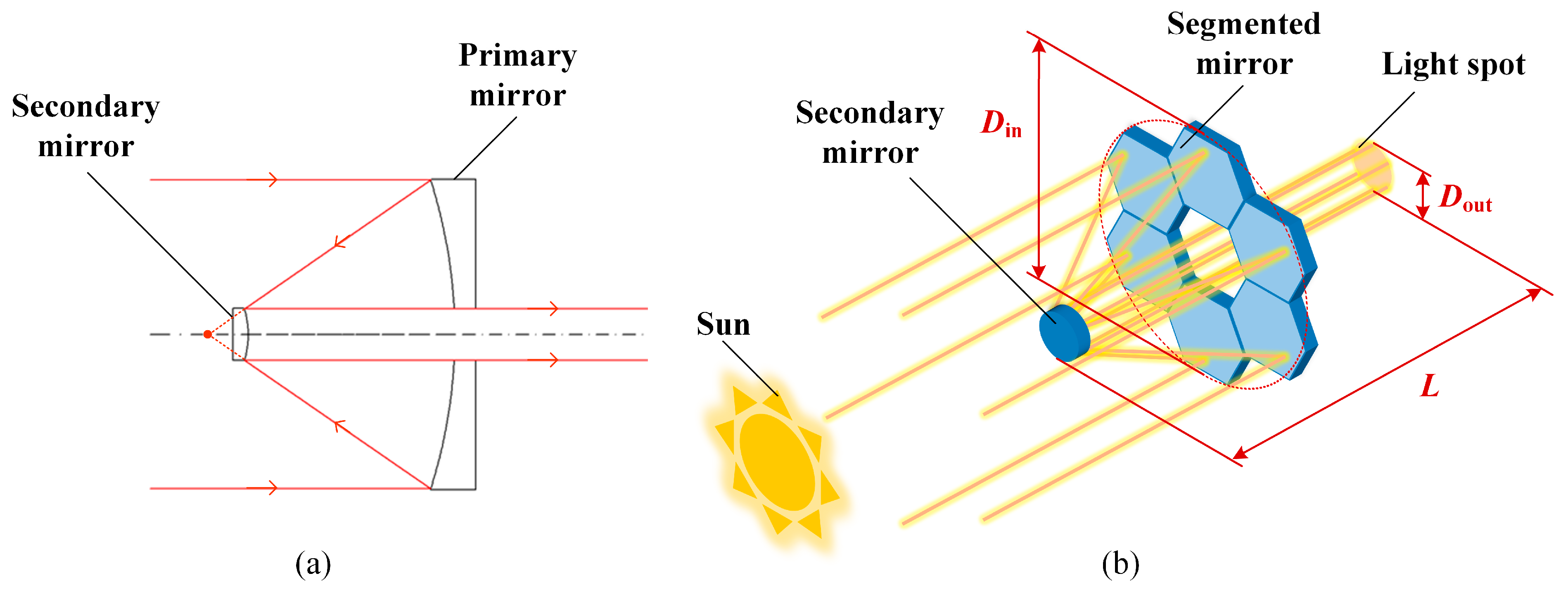
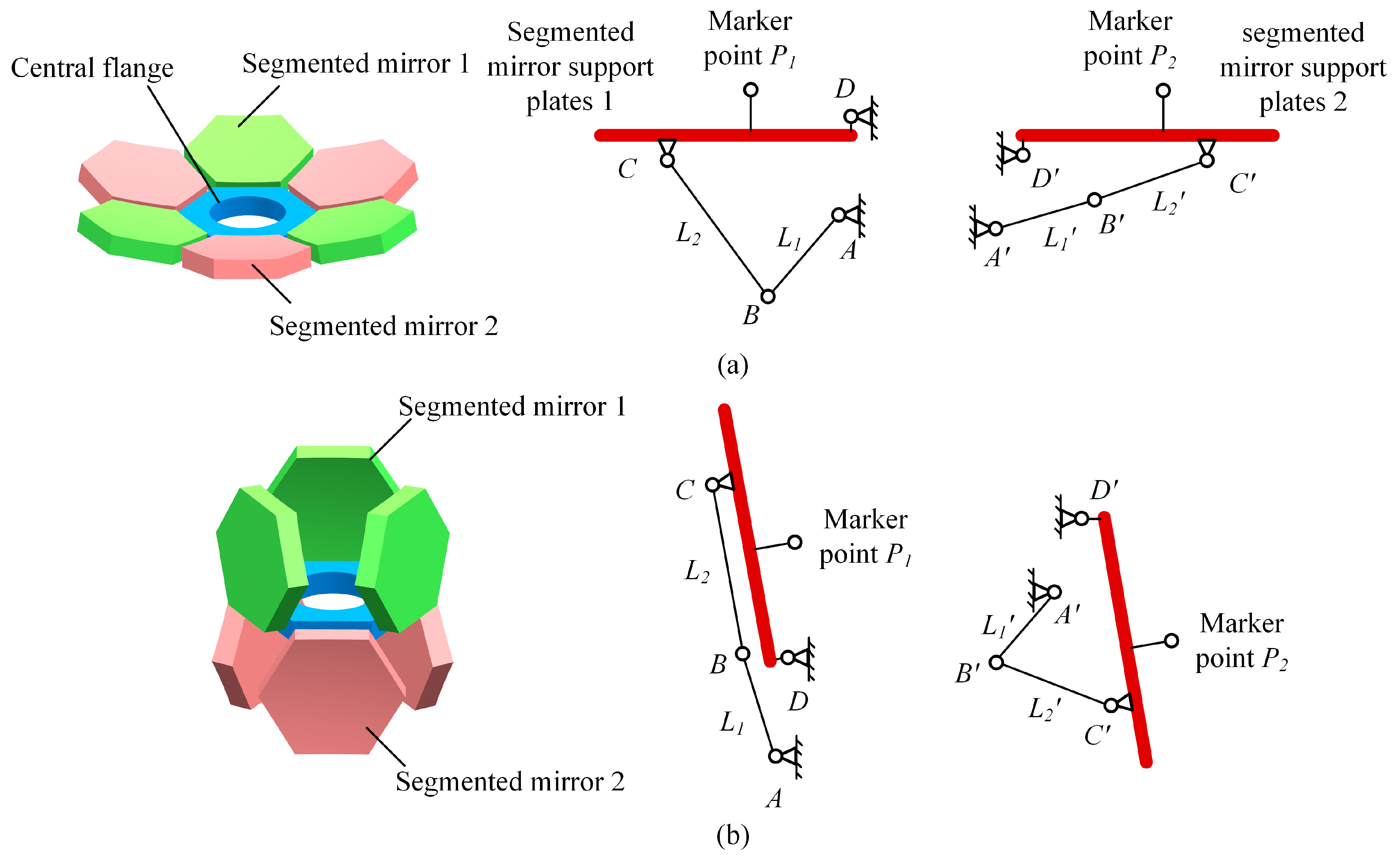
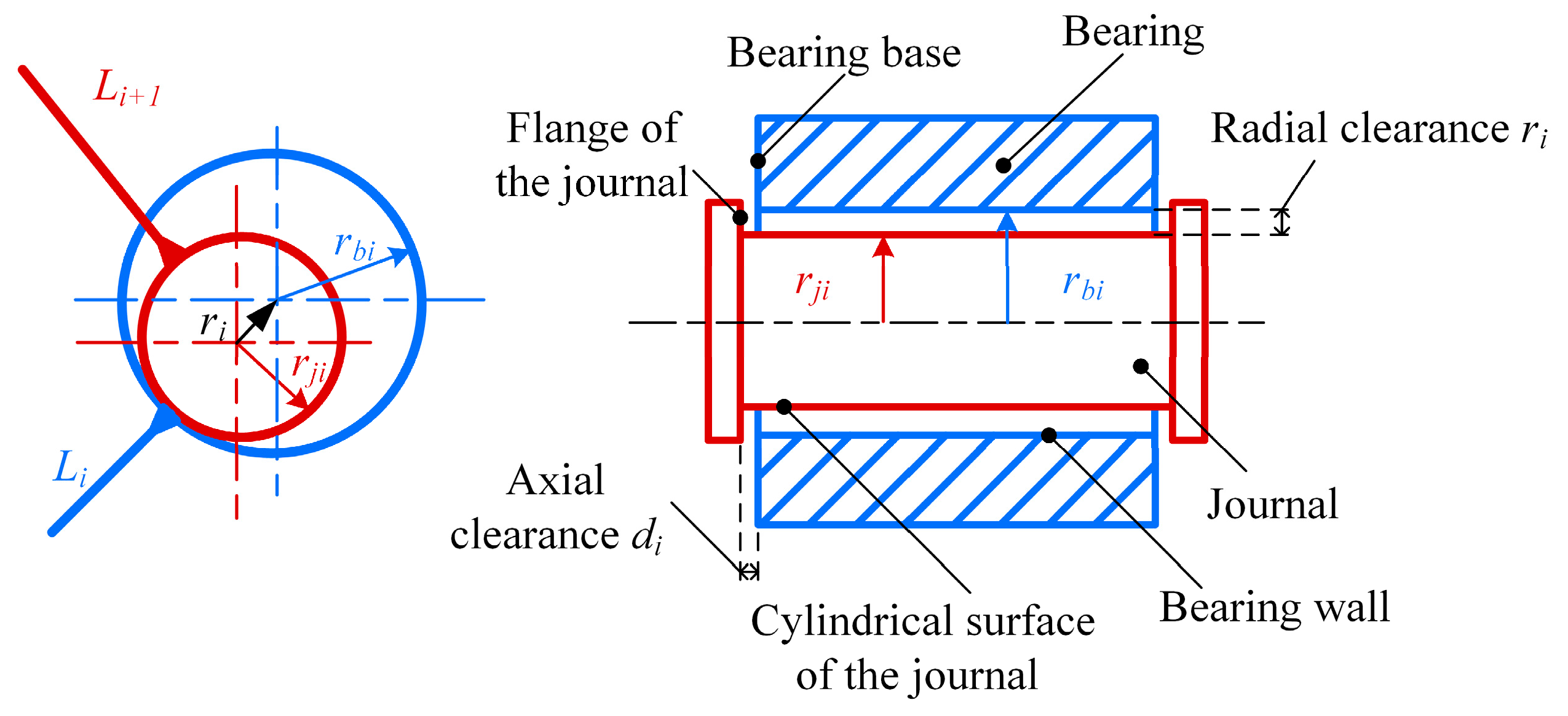
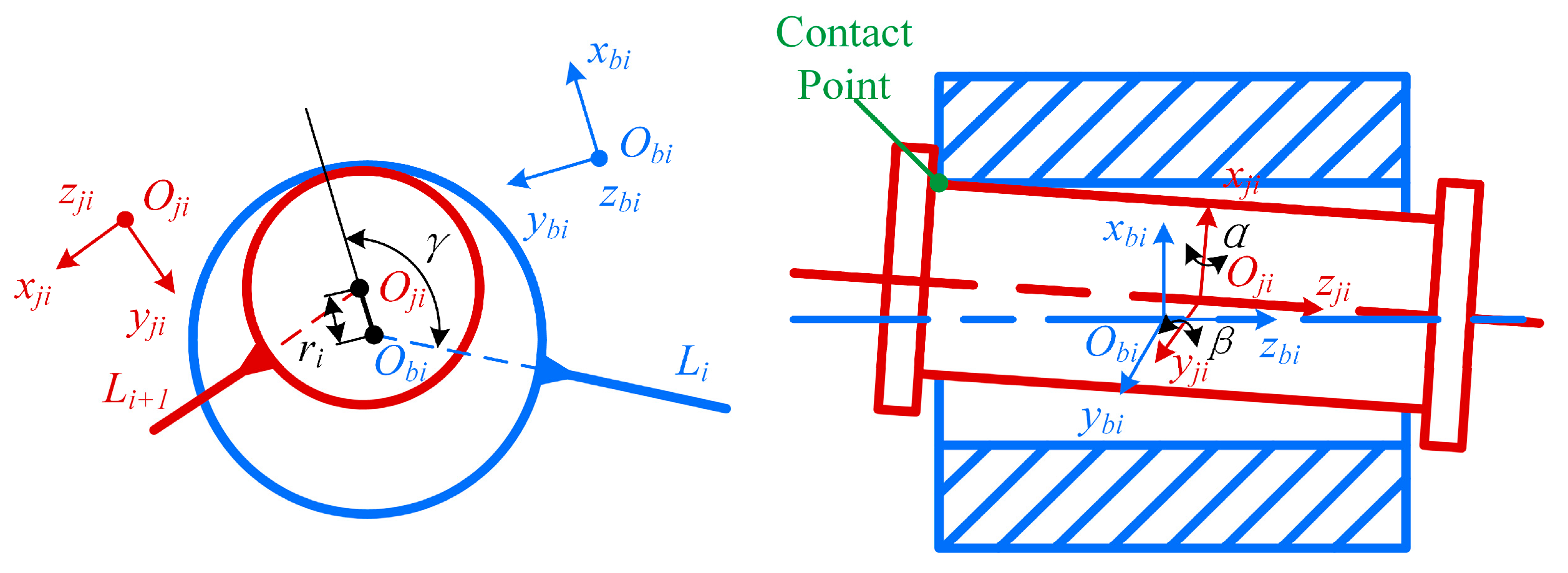
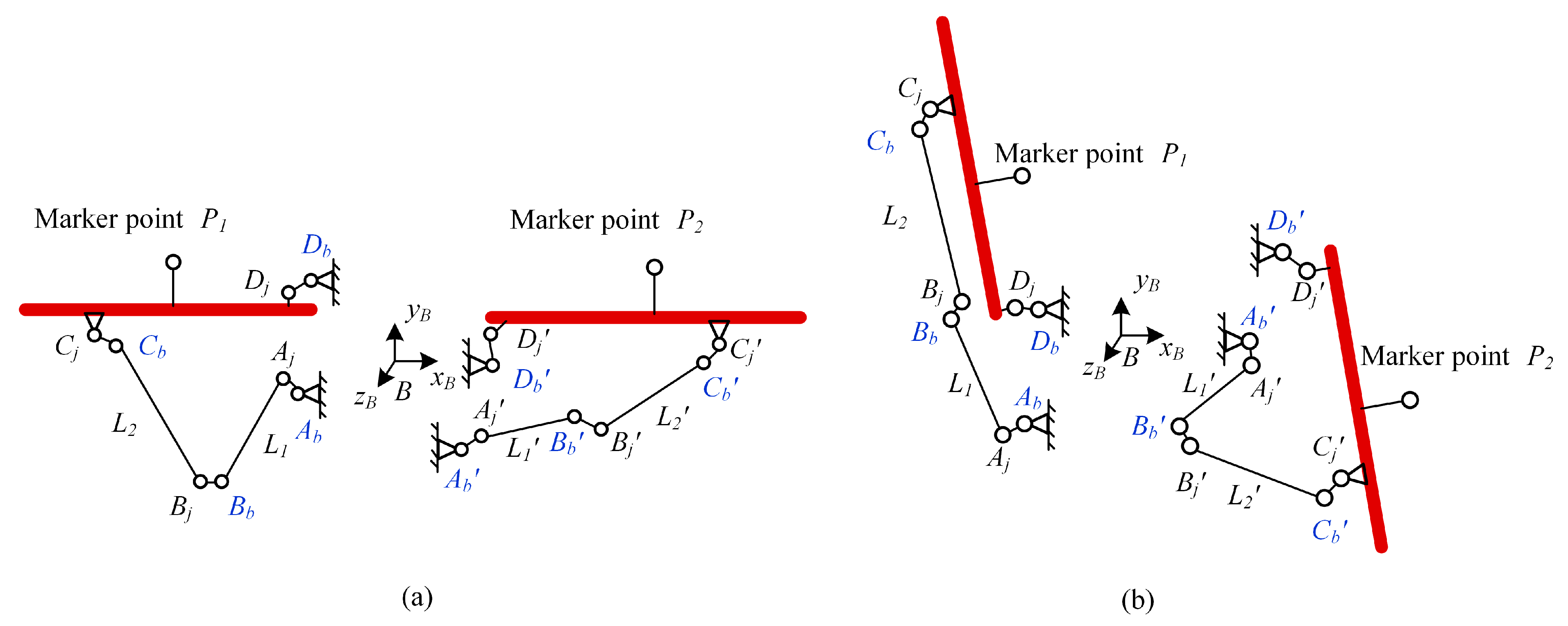

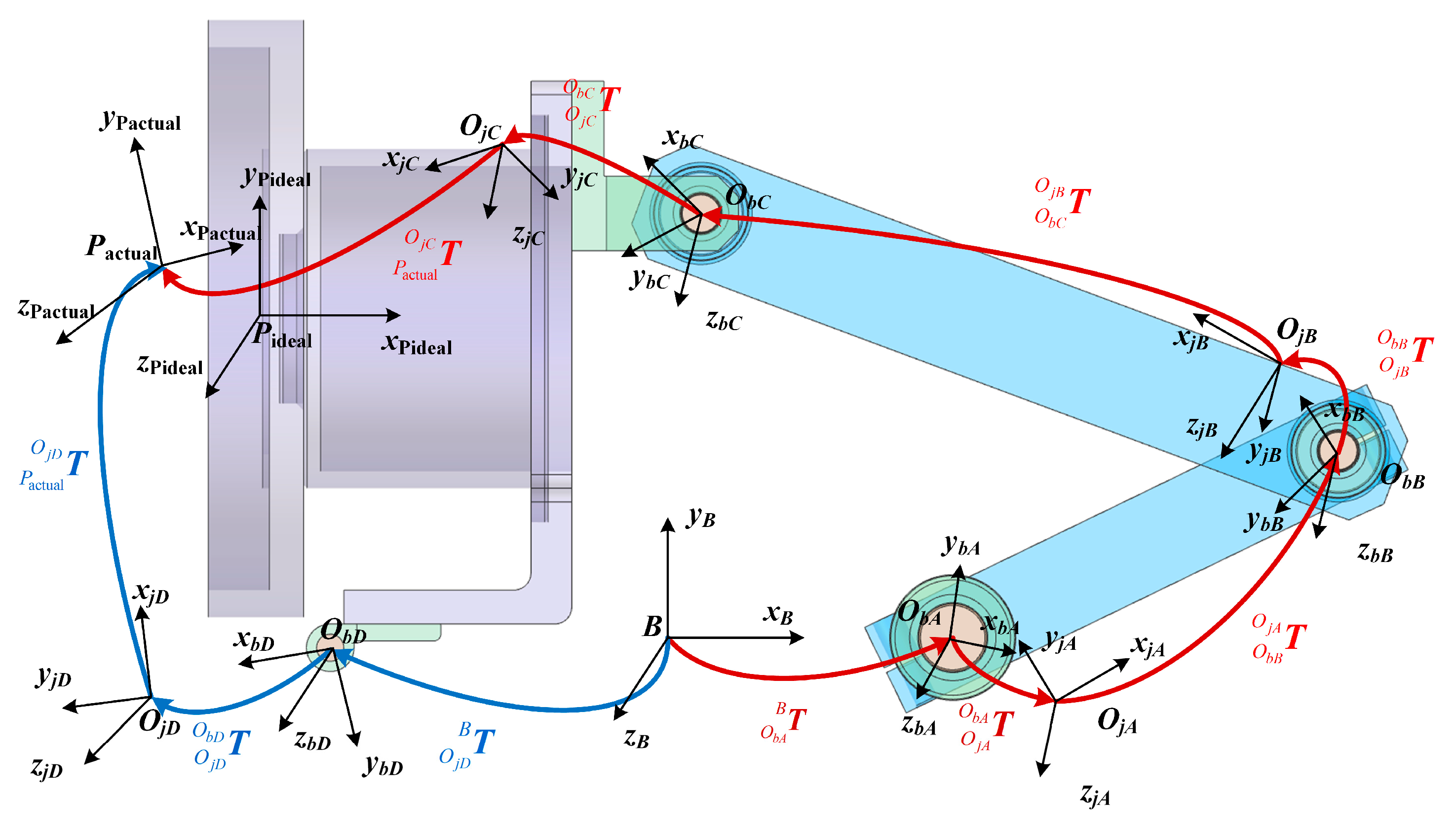
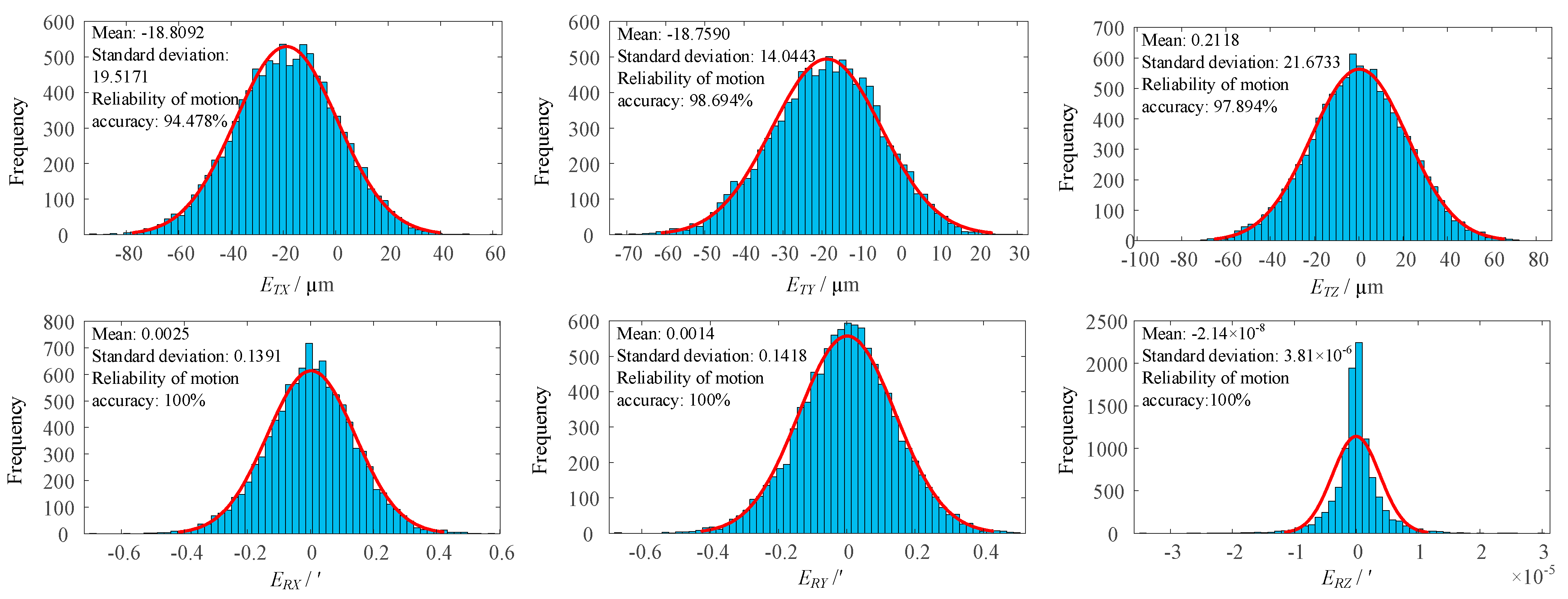
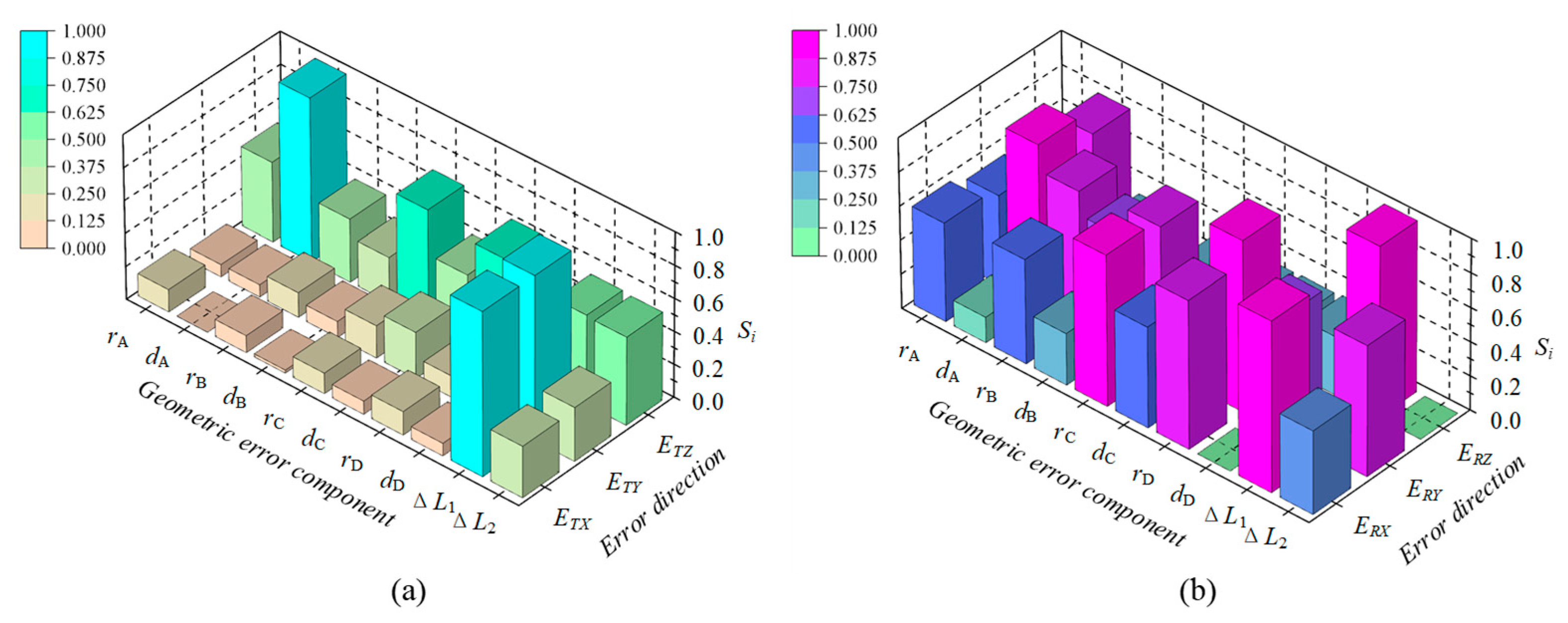
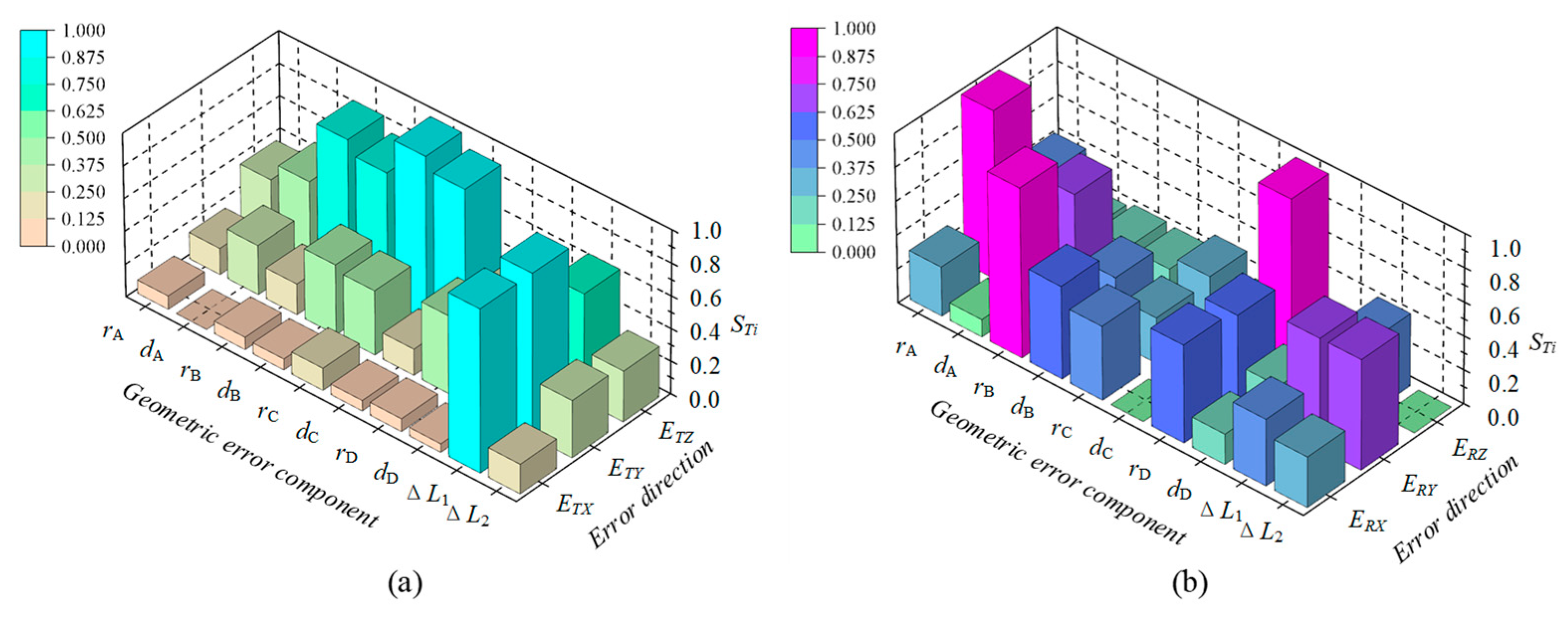
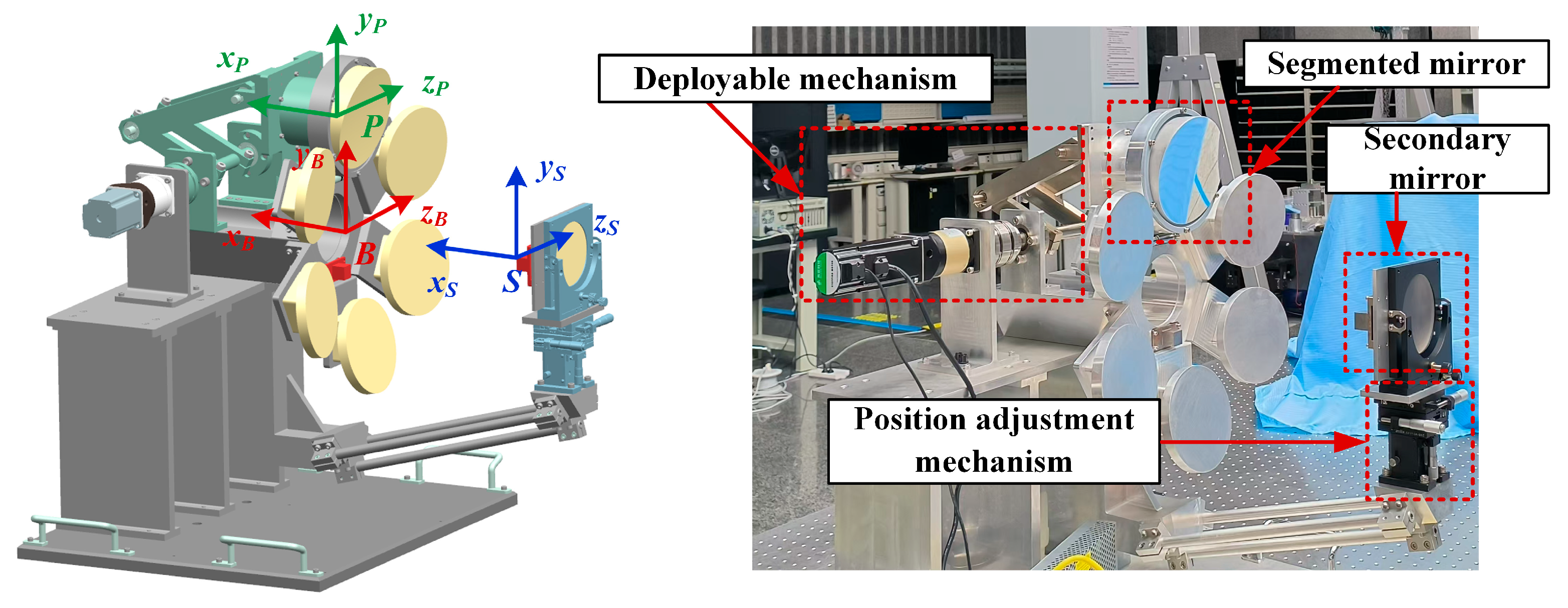
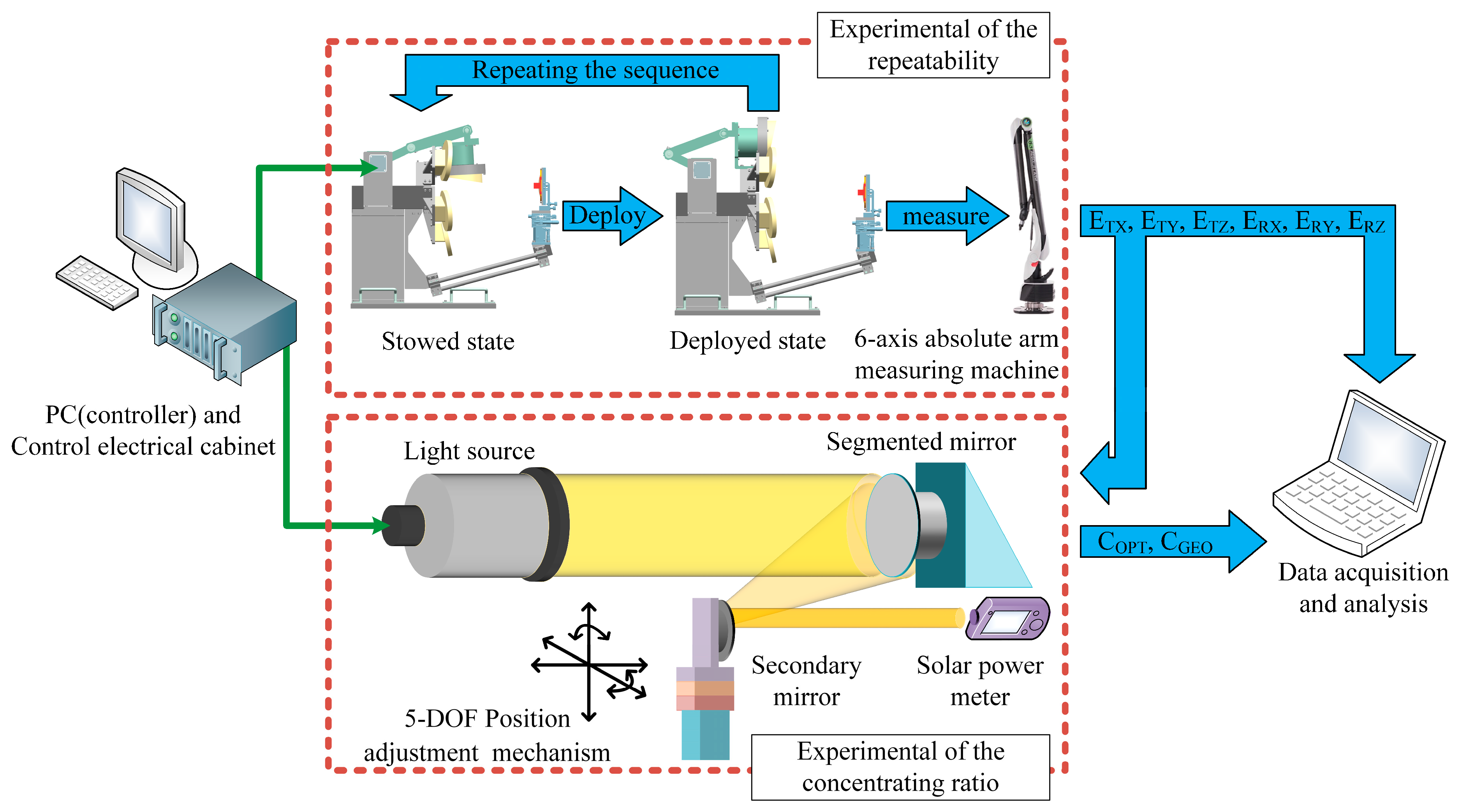
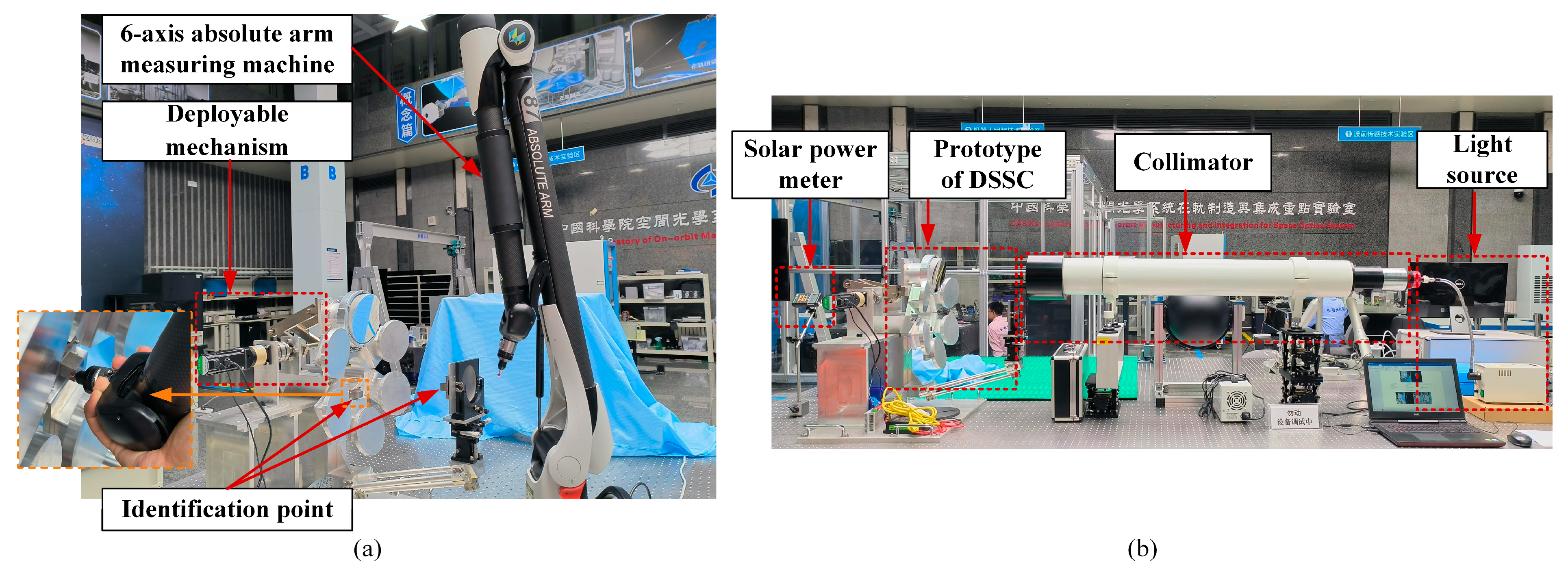


| Mirror | Radius of Curvature (mm) | Conic Coefficient | Half Aperture (mm) | Spacing (mm) |
|---|---|---|---|---|
| Segmented mirror | −800 | −1 | 75 | −333.33 |
| Secondary mirror | −133.33 | −1 | 45 |
| Error Component | Range (µm) | Mean (µm) | Standard Deviation (µm) |
|---|---|---|---|
| Radial clearance rA of revolute joint A | [2.5, 37] | 19.75 | 5.75 |
| Radial clearance rB of revolute joint B | [1.5, 32] | 16.75 | 5.08 |
| Radial clearance rC of revolute joint C | [1.5, 32] | 16.75 | 5.08 |
| Radial clearance rD of revolute joint D | [8, 22.5] | 15.25 | 2.42 |
| Axial clearance dA of revolute joint A | [−60, 60] | 0 | 20 |
| Axial clearance dB of revolute joint B | [−60, 60] | 0 | 20 |
| Axial clearance dC of revolute joint C | [−60, 60] | 0 | 20 |
| Axial clearance dD of revolute joint D | [−60, 60] | 0 | 20 |
| Length error ΔL1 of link L1 | [−50, 50] | 0 | 16.67 |
| Length error ΔL2 of link L2 | [−20, 20] | 0 | 6.67 |
| Mirror | Translation Error Along the y-Axis (µm) | Translation Error Along the z-Axis (µm) | Tip (′) | Tilt (′) | Piston (mm) |
|---|---|---|---|---|---|
| Segmented mirror | ±50 | ±50 | ±5 | ±5 | ±5 |
| Secondary mirror | ±50 | ±50 | ±5 | ±5 |
Disclaimer/Publisher’s Note: The statements, opinions and data contained in all publications are solely those of the individual author(s) and contributor(s) and not of MDPI and/or the editor(s). MDPI and/or the editor(s) disclaim responsibility for any injury to people or property resulting from any ideas, methods, instructions or products referred to in the content. |
© 2025 by the authors. Licensee MDPI, Basel, Switzerland. This article is an open access article distributed under the terms and conditions of the Creative Commons Attribution (CC BY) license (https://creativecommons.org/licenses/by/4.0/).
Share and Cite
Mei, J.; Han, C.; Xu, Z.; Qi, Y.; Meng, Q.; Yang, Z.; Li, Z. Design, Analysis, and Experimentation of Space Deployable Segmented Solar Concentrator. Aerospace 2025, 12, 713. https://doi.org/10.3390/aerospace12080713
Mei J, Han C, Xu Z, Qi Y, Meng Q, Yang Z, Li Z. Design, Analysis, and Experimentation of Space Deployable Segmented Solar Concentrator. Aerospace. 2025; 12(8):713. https://doi.org/10.3390/aerospace12080713
Chicago/Turabian StyleMei, Jinyuan, Chunyang Han, Zhenbang Xu, Yunsheng Qi, Qingyu Meng, Zipeng Yang, and Zhongyuan Li. 2025. "Design, Analysis, and Experimentation of Space Deployable Segmented Solar Concentrator" Aerospace 12, no. 8: 713. https://doi.org/10.3390/aerospace12080713
APA StyleMei, J., Han, C., Xu, Z., Qi, Y., Meng, Q., Yang, Z., & Li, Z. (2025). Design, Analysis, and Experimentation of Space Deployable Segmented Solar Concentrator. Aerospace, 12(8), 713. https://doi.org/10.3390/aerospace12080713







